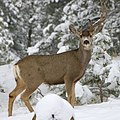Antler: Difference between revisions
Sjohnson111 (talk | contribs) |
|||
| Line 35: | Line 35: | ||
*[http://www.livescience.com/animals/ap_050319_deer_antlers.html 2005 article – additional recent views on the purpose of antlers] |
*[http://www.livescience.com/animals/ap_050319_deer_antlers.html 2005 article – additional recent views on the purpose of antlers] |
||
*[http://www.antlers-for-sale.com/antler-growth - Antler Growth Study] |
*[http://www.antlers-for-sale.com/antler-growth - Antler Growth Study] |
||
*[http://www.shanewilson.com - Shane Wilson Sculpture - from moose and caribou antler] |
|||
{{1728}} |
{{1728}} |
||
Revision as of 00:50, 8 April 2009
This article needs additional citations for verification. (November 2008) |

Antlers are the usually large and complex horn-like appendages of most deer species, mostly worn by males in true horns. Each antler grows from an attachment point on the skull called a pedicle. While an antler is growing it is covered with highly vascular skin called velvet, which supplies oxygen and nutrients to the growing bone; once the antler has achieved its proper size, the velvet is lost and the antler's bone dies. This dead bone structure is the mature antler. Antlers are shed after each mating season.
An advancer, a term used by hunters, is one of the starts or branches of a buck's attire between the back antler and the "palm" (the flattened part of the antlers). In other words, it is the second branch of a buck's horn.
Antlers appear to act as large hearing aids. This effect was discovered by researchers George and Peter Bubenik and published the findings in the European Journal of Wildlife in March 2008. Moose with antlers have far more sensitive hearing than moose without. The Bubeniks then studied trophy antlers with an artificial ear, confirming the discovery of the effects on hearing by acting as a parabolic reflector.[1]
Examples of various types of antlers
-
Elk or Wapiti
-
Arch Made of Elk Antlers
-
Antlers at the start of the season
-
Mule deer missing an antler
-
Sambar Deer with thick, forked beams for antlers.
See also
References
External links
- - Great Article on Antlers; Facts and Information
- 2005 article – additional recent views on the purpose of antlers
- - Antler Growth Study
- - Shane Wilson Sculpture - from moose and caribou antler
![]() This article incorporates text from a publication now in the public domain: Chambers, Ephraim, ed. (1728). Cyclopædia, or an Universal Dictionary of Arts and Sciences (1st ed.). James and John Knapton, et al.
This article incorporates text from a publication now in the public domain: Chambers, Ephraim, ed. (1728). Cyclopædia, or an Universal Dictionary of Arts and Sciences (1st ed.). James and John Knapton, et al. {{cite encyclopedia}}: Missing or empty |title= (help)










